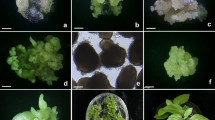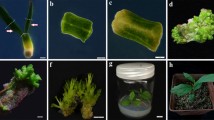Abstract
We developed an efficient plant regeneration technique for turmeric (Curcuma longa L.) via somatic embryogenesis derived from embryogenic cell suspensions cultured from petioles. We initiated in vitro callus cultures from the plantlets of turmeric cultured on Murashige and Skoog (MS) medium. Then leaf, petiole, stem, and root explants of in vitro-grown plantlets were cultured on Schenk and Hildebrandt (SH). The stem and root explants formed white nodular calluses at a frequency of 86.7% and 85.8%, respectively, when cultured on SH medium; however, we used the calluses derived from the root explants for initiating a cell-suspension culture. In this study, the actively growing cell suspension culture comprised small, highly cytoplasmic cell aggregates and large vacuolated cells. On being transferred to a basal SH medium (without growth regulators), a few of these calluses differentiated into somatic embryos, which indicated that the initial calluses were embryogenic cells. We stimulated additional shoot differentiation by adding 0.5 mg L−1N-phenyl-N′-1,2,3-thiadiazol-5-yl urea (TDZ) and various concentrations of N6-benzyladenine (BA) to the embryogenic cell suspension. The highest frequency at which shoot primordia developed from embryogenic cell clusters was 70% (when cultured in the dark on the supplemented MS medium), with more than 83.3% of regenerated shoot primordia producing roots. We successfully transplanted rooted plantlets into a soil mixture of sterile vermiculite and potting soil (1:1) and grew them to maturity in a growth chamber, achieving a survival rate of > 95%. To our knowledge, this is the first report of complete plant regeneration of turmeric from embryogenic cell-suspension cultures. The embryogenic cell line and plant regeneration system established in this study can be applied to mass proliferation and gene manipulation for improving turmeric quality.




Similar content being viewed by others
Abbreviations
- 2,4-D:
-
2,4-Dichlorophenoxyacetic acid
- BA:
-
N6-benzyladenine
- MS:
-
Murashige and Skoog medium
- NAA:
-
a-Naphthaleneacetic acid
- pCPA:
-
p-Chlorophenoxyacetic acid
- SH:
-
Schenk and Hildebrandt medium
- TDZ:
-
Thidiazuron
References
Aggarwal BB, Sung B (2009) Pharmacological basis for the role of curcumin in chronic diseases: an age-old spice with modern targets. Trends Pharmacol Sci 30:85–94
Balachandran SM, Bhat SR, Chandel KPS (1990) In vitro clonal multiplication of turmeric (Curcuma spp.) and ginger (Zingiber officinale Rosc.). Plant Cell Rep 8:521–524
Balasubramanian K (2006) Molecular orbital basis for yellow curry spice curcumin’s prevention of Alzheimer’s disease. J Agric Food Chem 54:3512–3520
Casanova E, Valdés AE, Fernández B, Moysset L, Trillas MI (2004) Levels and immunolocalization of endogenous cytokinins in thidiazuron-induced shoot organogenesis in carnation. J Plant Physiol 61:95–104
Das A, Kesari V, Rangan L (2010) Plant regeneration in Curcuma species and assessment of genetic stability of regenerated plants. Biol Plant 54:423–429
Egan ME, Pearson M, Weiner SA, Rajendran V, Rubin D, Glockner- Pagel J, Canny S, Du K, Lukacs GL, Caplan MJ (2004) Curcumin, a major constituent of turmeric, corrects cystic fibrosis defects. Science 304:600–602
Feyissa T, Welander M, Negash L (2005) In vitro regeneration of Hagenia abyssinica (Bruce) J.F. Gmel. (Rosaceae) from leaf explants. Plant Cell Rep 24:392–400
Gang DR, Ma XQ (2008) Ginger and turmeric, ancient spices and modern medicines. Springer, Berlin
Hashemy T, Maki H, Yamada Y, Kaneko TS, SyonoK (2009) Effects of light and cytokinin on in vitro micropropagation and microrhizome production in turmeric (Curcuma longa L.). Plant Biotechnol 26:237–242
He R, Gang DR (2014) Somatic embryogenesis and Agrobacterium-mediated transformation of turmeric (Curcuma longa). Plant Cell Tissue Organ Cult 116:333–342
John CK, Nadgauda RS, Mascarenhas AF (1997) Turmeric. In: Tissue culture of economic plants. Center for Science and Technology of the Non-Aligned and Other Developing Countries, New Delhi, pp 191–209
Kim SW, Oh SC, In DS, Liu JR (2003) Plant regeneration of rose (Rosa hybrida) from embryogenic cell-derived protoplasts. Plant Cell Tissue Organ Cult 73:15–19
Kou Y, Yuan C, Zhao Q, Liu G, Nie J, Ma Z, Cheng C, Teixeira da S, Jaime A, Zhao L (2016) Thidiazuron triggers morphogenesis in Rosa canina L. protocorm-Like bodies by changing incipient cell fate. Front Plant Sci 7:557
Li XQ, Krasnyanski SF, Korban SS (2002) Somatic embryogenesis, secondary somatic embryogenesis, and shoot organogenesis in Rosa. J Plant Physiol 159:313–319
Ma X, Gang DR (2006) Metabolic profiling of turmeric (Curcuma longa L.) plants derived from in vitro micropropagation and conventional greenhouse cultivation. J Agric Food Chem 54:9573–9583
Mohanty S, Panda MK, Subudhi E, Nayak S (2008) Plant regeneration from callus culture of Curcuma aromatica and in vitro detection of somaclonal variation through cytophotometric analysis. Biol Plant 52:783–786
Murashige T, Skoog F (1962) A revised medium for rapid and bioassays with tobacco tissue cultures. Physiol Plant 15:473–497
Murthy BNS, Murch SJ, Saxena PK (1998) Thidiazuron: a potent regulator of in vitro plant morphogenesis. In Vitro Cell Dev Biol Plant 34:267
Prathanturarug S, Chuakul W, Phaidee Y, Saralamp P, Soonthornchareonnon N (2003) High-frequency shoot multiplication in Curcuma longa L. using thidiazuron. Plant Cell Rep 21:1054–1059
Rahman MM, Ahmed R, Amin MN, Jahan HS (2004) In vitro regeneration of plantlets of Curcuma longa L. A valuable species plant in Bangladesh. Plant Sci 3:306–309
Salvi ND, Eapen S, George L (2000) Direct regeneration of shoots from immature inflorescence cultures of turmeric. Plant Cell Tissue Organ Cult 62:235–238
Salvi ND, Eapen S, George L (2001) Plant regeneration from leaf base callus of turmeric and random amplified polymorphic DNA analysis of regenerated plants. Plant Cell Tissue Organ Cult 66:113–119
Salvi ND, George L, Eapen S (2002) Micropropagation and field evaluation of micropropagated plants of turmeric. Plant Cell Tissue Organ Cult 68:143–151
Schenk RU, Hildebrandt AC (1972) Medium and techniques for induction and growth of monocotyledonous and dicotyledonous plant cell cultures. Can J Bot 50(1):199–204
Shirgurkar MV, John CK, Nadgauda RS (2001) Factors affecting in vitro microrhizome production in turmeric. Plant Cell Tissue Organ Cult 64:5–11
Shirgurkar MV, Naik VB, von Arnold S, Nadgauda RS, Clapham D (2006) An efficient protocol for genetic transformation and shoot regeneration of turmeric (Curcuma longa L.) via particle bombardment. Plant Cell Rep 25:112–116
Singh S, Kuanar A, Mohanty S, Subudhi E, Nayak S (2011) Evaluation of phytomedicinal yield potential and molecular profiling of micropropagated and conventionally grown turmeric (Curcuma longa L.). Plant Cell Tissue Organ Cult 104:263–269
Thomas JC, Katterman FR (1986) Cytokinin activity induced by thidiazuron. Plant Physiol 81:681–683
Tyagi RK, Yusuf A, Dua P, Agrawal A (2004) In vitro plant regeneration and genotype conservation of eight wild species of Curcuma. Biol Plant 48:129–132
Acknowledgements
This work was supported by a grant from the KRIBB Research Initiative Program (KGM5281812).
Author information
Authors and Affiliations
Corresponding author
Additional information
Publisher's Note
Springer Nature remains neutral with regard to jurisdictional claims in published maps and institutional affiliations
Rights and permissions
About this article
Cite this article
Jie, E.Y., Ahn, M.S., Lee, J. et al. Establishment of a high-frequency plant regeneration system from rhizome-derived embryogenic cell-suspension cultures of Curcuma longa L.. Plant Biotechnol Rep 13, 123–129 (2019). https://doi.org/10.1007/s11816-019-00519-2
Received:
Accepted:
Published:
Issue Date:
DOI: https://doi.org/10.1007/s11816-019-00519-2




